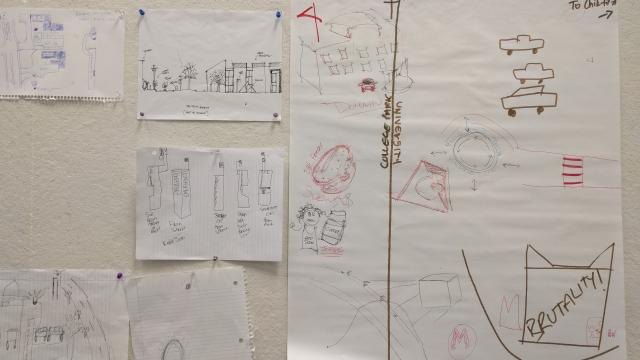Cities have the power to create an all-out assault on the senses. Ambient noise, in particular—the honk of a horn, a barking dog or the gleeful screams of a playground—can blend together into an auditory soup so droning and constant that we may tune it out completely. But what would happen if you stopped and truly listened to a city street's audio narrative? What would it tell you about a neighborhood’s social makeup, economic fabric or political affiliations? This past spring, 23 University of Maryland urban planning students created soundscapes of D.C., College Park, Langley Park and Baltimore to capture and interpret their urban soundtracks, as part of their Qualitative Research Methods course. Their stories will debut this month on CoLab Radio, a city and regional planning publication of the Community Innovators Lab (CoLab) at the Massachusetts Institute of Technology.
The idea behind the project came to Assistant Professor of Urban Studies and Planning Ariel Bierbaum after learning about theories of urban sound and listening to a few of examples on CoLab’s site. For their coursework, each student chose a neighborhood or site of interest to their research. They recorded the soundscapes of their particular site in addition to conducting more traditional research observations and interviews. They studied the playback for clues that might otherwise be missed by sight alone, which informed a narrative about the neighborhood.
Previous soundwalks posted on CoLab, conducted by people from around the world, offered a good primer for Bierbaum’s students. The sound of a sweeping broom in Third Ward, Texas, reveals a sense of stewardship. A soundscape of a neighborhood in Los Angeles revealed the push and pull of a gentrifying neighborhood, as newly-transplanted residents muse about a menu item called “Horchata” at a local café. Coming in at only 2 to 5 minutes each, these miniature stories offer revealing aspects of neighborhood culture, heritage and changing landscapes.
“Most of the tools of urban planning are more quantitative and, while they help us learn some things about the urban environment, they also strip away some of our sensory inputs,” Bierbaum says. She hedges that the auditory exercise of leaning into the environment and learning what our senses are telling us is another important “tool in the toolbox” to help planners understand a broader narrative.
“No one is in this business because we care about curb cuts,” said Bierbaum. “It maybe what we tactically talk about sometimes, but we care about making places that feel good, so we need to find ways to reintroduce the use of our feelings and sense back into the research and design of our places.”
The soundwalks will be published on MIT's CoLab Radio each Sunday. Read the first introductory post here, and follow along on Twitter, using the hashtag #soundwalksunday.

